Fiscal Economics Notes 12th Economics
12th Economics Lesson 7 Notes in English
7. Fiscal Economics
| “Incomings may be scant; but yet, no failures there, If in expenditure you rightly learn to spare”. – Thirukkural No.478 |
Introduction
- The term ‘Fiscal Economics’ is a new one; the old and popular term of the subject is ‘Public Finance’.
- The subject Public Finance is related to the financing of the State activities and it discusses the financial operations of the Government treasury.
- The term fiscal is derived from Greek word which means basket and symbolizes the public purse.
- Hence the subject ‘Public Finance’ has been newly termed ‘Fiscal Economics’.
- Public Finance studies the manner in which the state raises and spends the resources.
- The state is concerned with the collective wants of the citizens. The modern state is a welfare state.
- The activities of the state have increased extensively and intensively.
- To perform these activities, the state needs funds.
- This chapter deals with the Public Revenue, Public Expenditure, Public Debt, Budget, Federal Finance and Local Finance.
Meaning of Public Finance
- Public finance is a study of the financial aspects of Government.
- It is concerned with the revenue and expenditure of the public authorities and with adjustment of the one to the other.
Definitions
| “Public finance is one of those subjects that lie on the border line between Economics and Politics. It is concerned with income and expenditure of public authorities and with the adjustment of one to the other”. –Huge Dalton |
| “Public finance is an investigation into the nature and principles of the state revenue and expenditure”. –Adam Smith |
Subject Matter / Scope of Public Finance
- In Modern times, the subject ‘Public Finance’ includes five major sub-divisions, viz., Public Revenue, Public Expenditure, Public Debt, Financial Administration and Fiscal Policy.
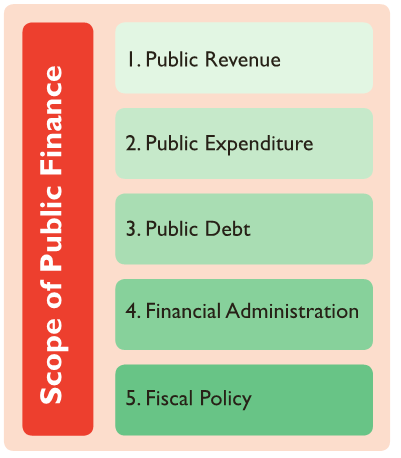
Scope of Public Finance
- Public Revenue
- Public Expenditure
- Public Debt
- Financial Administration
- Fiscal Policy
1. Public Revenue
- Public revenue deals with the methods of raising public revenue such as tax and non-tax, the principles of taxation, rates of taxation, impact, incidence and shifting of taxes and their effects.
2. Public Expenditure
- This part studies the fundamental principles that govern the Government expenditure, effects of public expenditure and control of public expenditure.
3. Public Debt
- Public debt deals with the methods of raising loans from internal and external sources.
- The burden, effects and redemption of public debt fall under this head.
4. Financial Administration
- This part deals with the study of the different aspects of public budget.
- The budget is the Annual master financial plan of the Government.
- The various objectives and steps in preparing a public budget, passing or sanctioning, allocation evaluation and auditing fall within financial administration.
5. Fiscal Policy
- Taxes, subsidies, public debt and public expenditure are the instruments of fiscal policy.
Public finance and Private finance
- Public finance deals with study of income, expenditure, borrowing and financial administration of the government.
- Private finance is the study of income, expenditure, borrowing and financial administration of individual or private companies.
- Both public and private finance are fundamentally similar in nature but different from each other on various operational aspects.
- The similarities and dissimilarities between public and private finance have been explained below.
Similarities
- Rationality both public finance and private finance are based on rationality. Maximization of welfare and least cost factor combination underlie both.
- Limit to borrowing both have to apply restraint with regard to borrowing. The Government also cannot live beyond its means. There is a limit to deficit financing by the state also.
- Resource utilisation both the private and public sectors have limited resources at their disposal. So both attempt to make optimum use of resources.
- Administration the effectiveness of measures of the Government as well as private depends on the administrative machinery. If the administrative machinery is inefficient and corrupt it will result in wastages and losses.
Dissimilarities
1. Income and Expenditure adjustment
- The government adjusts the income to the expenditure while individuals adjust their expenditure to the income.
- Private finance involves stitching coat according to cloth available whereas public finance decides the cloth according to the need for the coat.
2. Borrowing
- The government can borrow from internal and external sources; it can borrow from the people by issuing bonds.
- However, an individual cannot borrow from himself.
3. Right to print currency
- The government can print currency.
- This involves the creation, distribution and monitoring of currency.
- The private sector cannot create currency.
4. Present vs. future decisions
- The public finance is more involved with future planning and making long- term decisions.
- These investments could include building of schools, hospitals and infrastructure.
- The private finance makes financial decisions on projects with a short term vision.
5. Objective
- The public sector’s main objective is to provide social benefit in the economy.
- The private sector aims to maximize personal benefit i.e. Profit.
6. Coercion to get revenue
- The sources of income of a private individual is relatively limited while those of the Government is wide.
- The Government can use its power and authority.
7. Ability to make huge and deliberate changes
- The public finance has the ability to make big decisions on income.
- For example, it can effectively and deliberately adjust the revenue.
- But individuals cannot make such massive decisions.
Functions of Modern State
- The modern state is a welfare state and not just police state.
- The state assumes greater roles by creating economic and social overheads, ensuring stability both internally and externally, conserving resources for sustainable development and so on.
(i) Defence
- The primary function of the Government is to protect the people from external aggression and internal disorder.
- The government has to maintain adequate police and military forces and render protective services.
(ii) Judiciary:
- Rendering justice and settlement of disputes are the concern of the government.
- It should provide adequate judicial structure to render justice to all classes of citizens.
(iii) Enterprises
- The regulation and control of private enterprise fall under the purview of the modern State.
- Ownership of certain enterprises and operating them successfully are the responsibilities of the government.
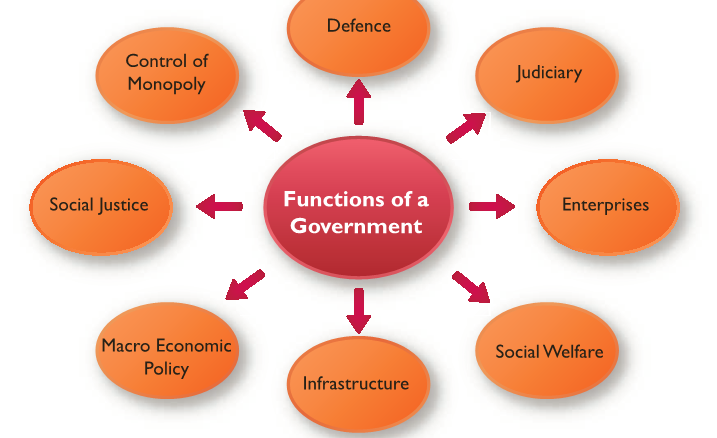
Functions of a Government
- Defence
- Judiciary
- Enterprises
- Social Welfare
- Infrastructure
- Macro Economic Policy
- Social Justice
- Control of Monopoly
(iv) Social Welfare
- It is the duty of the state to make provisions for education, social security, social insurance, health and sanitation for the betterment of the people in the country.
(v) Infrastructure Modern
- States have to build the base for the economic development of the country by creating social and economic infrastructure.
(vi)Macro-economic policy
- The Government has to administer fiscal policy and monetary policy to achieve macro-economic goals.
(vii) Social Justice
- During the process of growth of an economy, certain sections of the society gain at the cost of others.
- The Government needs to intervene with fiscal measures to redistribute income.
(viii) Control of Monopoly
- Concentration of economic power is another evil to be corrected by the Government.
- So, the state intervenes through control of monopolies and restrictive trade practices to curb concentration of economic power.
- In fine, the state can play three kinds of roles.
- As a producer of goods and services.
- As a supplier of public goods and social goods.
- As a regulator of the system.
Public Expenditure
Meaning
- Public expenditure refers to Government spending incurred by Central, State and Local governments of a country.
Definition
- Public expenditure can be defined as, “The expenditure incurred by public authorities like central, state and local governments to satisfy the collective social wants of the people is known as public expenditure”.
Classification of public expenditure are as follows:
1. Classification on the Basis of Benefit:
- Cohn and Plehn have classified the public expenditure on the basis of benefit into four classes:
- Public expenditure benefiting the entire society, e.g., the expenditure on general administration, defence, education, public health, transport.
- Public expenditure conferring a special benefit on certain people and at the same time common benefit on the entire community, e.g. administration of justice etc.
- Public expenditure directly benefiting particular group of persons and indirectly the entire society, e.g. social security, public welfare, pension, unemployment relief etc.
- Public expenditure conferring a special benefit on some individuals, e.g., subsidy granted to a particular industry.
2. Classification on the Basis of Function:
- Adam Smith classified public expenditure on the basis of functions of government in the following main groups:
a) Protection Functions:
- This group includes public expenditure incurred on the security of the citizens, to protect from external invasion and internal disorder, e.g., defence, police, courts etc.
b) Commercial Functions:
- This group includes public expenditure incurred on the development of trade and commerce, e.g., development of means of transport and communication etc.
c) Development Functions:
- This group includes public expenditure incurred for the development infrastructure and industry.
Causes for the Increase in Government Expenditure
- The modern state is a welfare state.
- In a welfare state, the government has to perform several functions viz Social, economic and political.
- These activities are the cause for increasing public expenditure.
1. Population Growth
- During the past 67 years of planning, the population of India has increased from 36.1 crore in 1951, to 121 crore in 2011.
- The growth in population requires massive investment in health and education, law and order, etc.
- Young population requires increasing expenditure on education & youth services, whereas the aging population requires transfer payments like old age pension, social security & health facilities.
2. Defence Expenditure
- There has been enormous increase in defence expenditure in India during planning period.
- The defence expenditure has been increasing tremendously due to modernisation of defence equipment.
- The defence expenditure of the government was Rs 10,874crores in 1990-91 which increased significantly to Rs 2,95,511crores in 2018-19.
3. Government Subsidies
- The Government of India has been providing subsidies on a number of items such as food, fertilizers, interest on priority sector lending, exports, education, etc.
- Because of the massive amounts of subsidies, the public expenditure has increased manifold.
- The expenditure on subsidies by central government in 1990-91 was Rs 9581 crores which increased significantly to Rs 2, 29,715.67 crores in 2018-19.
- Besides this, the corporate sectors also receive subsidies (incentives) of more than Rs 5 lakh crores.
4. Debt Servicing
- The government has been borrowing heavily both from the internal and external sources,
- As a result, the government has to make huge amounts of repayment towards debt servicing.
- The interest payment of the central government has increased from Rs 21,500 crores in 1990-91 to Rs 5, 75,794crores in 2018-19.
5. Development Projects
- The government has been undertaking various development projects such as irrigation, iron and steel, heavy machinery, power, telecommunications, etc.
- The development projects involve huge investment.
6. Urbanisation
- There has been an increase in urbanization.
- In 1950-51 about 17% of the population was urban based.
- Now the urban population has increased to about 43%.
- There are more than 54 cities above one million population.
- The increase in urbanization requires heavy expenditure on law and order, education and civic amenities.
7. Industrialisation
- Setting up of basic and heavy industries involves a huge capital and long gestation period.
- It is the government which starts such industries in a planned economy.
- The under developed countries need a strong of infrastructure like transport, communication, power, fuel, etc.
8. Increase in grants in aid to state and union territories
- There has been tremendous increase in grant-in-aid to state and union territories to meet natural disasters.
Public Revenue
- Public revenue occupies an important place in the study of public finance.
- The Government has to perform several functions for the welfare of the people.
- They involve substantial amount of public expenditure which can be financed only through public revenue.
- The amount of public revenue to be raised depends on the necessity of public expenditure and the people’s ability to pay.
Meaning
- The income of the government through all sources is called public income or public revenue.
- According to Dalton, the term “Public Income” has two senses — wide and narrow.
- In its wider sense it includes all the incomes or receipts which a public authority may secure during any period of time.
- In its narrow sense, it includes only those sources of income of the public authority which are ordinarily known as “revenue resources.”
- To avoid ambiguity, the former is termed “public receipts” and the latter “public revenue.”
- In a narrow sense, it includes only those sources of income of the Government which are described as “revenue resources”.
- In broad sense, it includes loans raised by the Government also.
Classification of Public Revenue.
- Public revenue can be classified into two types.
Tax Revenue
Meaning
- Tax is a compulsory payment by the citizens to the government to meet the public expenditure.
- It is legally imposed by the government on the tax payer and in no case tax payer can refuse to pay taxes to the government.
Definitions
| “A Tax is a compulsory payment made by a person or a firm to a government without reference to any benefit the payer may derive from the government.” -Anatol Murad |
| “A Tax is a compulsory contribution imposed by public authority, irrespective of the exact amount of service rendered to the tax payer in return and not imposed as a penalty for any legal offence.” – Dalton |
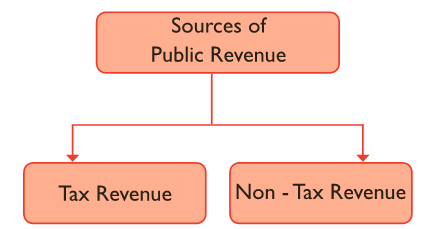
Sources of Public Revenue
- Tax Revenue
- Non – Tax Revenue
Characteristics of Tax

- A tax is a compulsory payment made to the government. People on whom a tax is imposed must pay the tax. Refusal to pay the tax is a punishable offence.
- There is no quid pro quo between a taxpayer and public authorities. This means that the tax payer cannot claim any specific benefit against the payment of a tax.
- Every tax involves some sacrifice on part of the tax payer.
- A tax is not levied as a fine or penalty for breaking law.
Some of the tax revenue sources are
- Income tax
- Corporate tax
- Sales tax
- Surcharge and
- Cess
Non-Tax Revenue
- The revenue obtained by the government from sources other than tax is called Non-Tax Revenue. The sources of non-tax revenue are
1. Fees
- Fees are another important source of revenue for the government.
- A fee is charged by public authorities for rendering a service to the citizens.
- Unlike tax, there is no compulsion involved in case of fees.
- The government provides certain services and charges certain fees for them. For example, fees are charged for issuing of passports, driving licenses, etc.
2. Fine
- A fine is a penalty imposed on an individual for violation of law.
- For example, violation of traffic rules, payment of income tax after the stipulated time etc.
3. Earnings from Public Enterprises
- The Government also gets revenue by way of surplus from public enterprises.
- Some of the public sector enterprises do make a good amount of profits.
- The profits or dividends which the government gets can be utilized for public expenditure.
4. Special assessment of betterment levy
- It is a kind of special charge levied on certain members of the community who are beneficiaries of certain government activities or public projects.
- For example, due to a public park or due to the construction of a road, people in that locality may experience an appreciation in the value of their property or land.
5. Gifts, Grants and Aids
- A grant from one government to another is an important source of revenue in the modern days.
- The government at the Centre provides grants to State governments and the State governments provide grants to the local government to carry out their functions.
- Grants from foreign countries are known as Foreign Aid.
- Developing countries receive military aid, food aid, technological aid, etc. from other countries.
6. Escheats
- It refers to the claim of the state to the property of persons who die without legal heirs or documented will.
Canons of Taxation:

- The characteristics or qualities which a good tax should possess are described as canons of taxation.
- It must be noted that canons refer to the qualities of an isolated tax and not to the tax system as a whole.
- A good tax system should have a proper combination of all kinds of taxes having different canons.
- According to Adam Smith, there are four canons or maxims of taxation. They are as follows:
Canons of Taxation
- Canon of Ability
- Canon of Certainty
- Canon of Convenience
- Canon of Economy
1. Canon of Ability
- The Government should impose tax in such a way that the people have to pay taxes according to their ability.
- In such case a rich person should pay more tax compared to a middle class person or a poor person.
2. Canon of Certainty
- The Government must ensure that there is no uncertainty regarding the rate of tax or the time of payment.
- If the Government collects taxes arbitrarily, then these will adversely affect the efficiency of the people and their working ability too.
3. Canon of Convenience
- The method of tax collection and the timing of the tax payment should suit the convenience of the people.
- The Government should make convenient arrangement for all the tax payers to pay the taxes without difficulty.
4. Canon of Economy
- The Government has to spend money for collecting taxes, for example, salaries are given to the persons who are responsible for collecting taxes.
- The taxes, where collection costs are more are considered as bad taxes.
- Hence, according to Smith, the Government should impose only those taxes whose collection costs are very less and cheap.
Direct Tax and Indirect Tax
Direct Tax
- A direct tax is referred to as a tax levied on person’s income and wealth and is paid directly to the government; the burden of such tax cannot be shifted.
- The tax is progressive in nature.
- It is levied according to the paying capacity of the person, i.e. the tax is collected more from the rich and less from the poor people.
- The plans and policies of the Direct Taxes are being recommended by the Central Board of Direct Taxes (CBDT) which is under the Ministry of Finance, Government of India.
| Direct Taxes | Indirect Taxes |
|
|
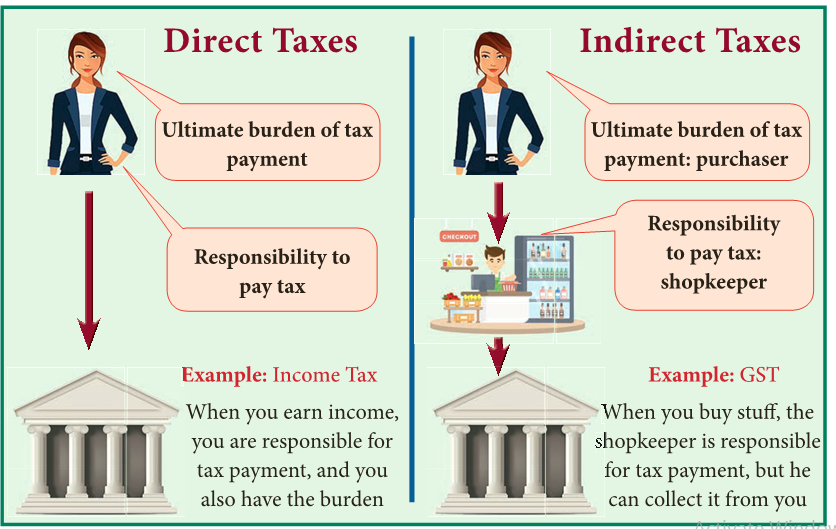
Merits of Direct Taxes
- Equity Direct taxes are progressive i.e. rate of tax varies according to tax base. For example, income tax satisfies the canon of equity.
- Certainity: Canon of certainty can be ensured by direct taxes. For example, an income tax payer knows when and at what rate he has to pay income tax.
- Elasticity: Direct taxes also satisfy the canon of elasticity. Income tax is income elastic in nature. As income level increases, the tax revenue to the Government also increases automatically.
- Economy: The cost of collection of direct taxes is relatively low. The tax payers pay the tax directly to the state.
Demerits of Direct Taxes
- Unpopular: Direct taxes are generally unpopular. It is inconvenient and less flexible.
- Productivity affected: According to many economists direct tax may adversely affect productivity. Citizens are not willing to earn more income because in that case they have to pay more taxes.
- Inconvenient: The tax payers find it inconvenient to maintain accounts, submit returns and pay tax in lump sum.
- Tax Evasion: The burden of direct tax is so heavy that tax-payers always try to evade taxes. This ultimately leads to the generation of black money, which is harmful to the economy.
Indirect Tax
- Indirect Tax is referred to as a tax charged on a person who purchases the goods and services and it is paid indirectly to the government.
- The burden of tax can be easily shifted to the another person.
- It is levied on all persons equally whether rich or poor.
- There are several types of Indirect Taxes, such as:
- Excise Duty: Payable by the manufacturer who shifts the tax burden to retailers and wholesalers.
- Sales Tax: Paid by a shopkeeper or retailer, who then shifts the tax burden to customers by charging sales tax on goods and services.
- Custom Duty: Import duties levied on goods from outside the country, ultimately paid for by consumers and retailers.
- Entertainment Tax: Liability is on the cinema theatre owners, who transfer the burden to cinema goers.
- Service Tax: Charged on services like telephone bill, insurance premium such as food bill in a restaurant etc.
Merits of Indirect Taxes
(1) Wider Coverage
- All the consumers, whether they are rich or poor, have to pay indirect taxes.
- For this reason, it is said that indirect taxes can cover more people than direct taxes.
- For example, in India everybody pays indirect tax as against just 2 percent paying income tax.
(2) Equitable
- The indirect tax satisfies the canon of equity when higher tax is imposed on luxuries used by rich people.
(3) Economical
- Cost of collection is less as producers and retailers collect tax and pay to the Government. The traders act as honorary tax collectors.
(4) Checks harmful consumption
- The Government imposes indirect taxes on those commodities which are harmful to health e.g. tobacco, liquor etc. They are known as sin taxes.
(5) Convenient
- Indirect taxes are levied on commodities and services.
- Whenever consumers make purchase, they pay tax along with the price.
- They do not feel the pinch of paying tax.
Demerits of Indirect Taxes
(1) Higher Cost of Collection
- The cost of collection of indirect taxes is higher than the direct taxes.
- The Government has to spend huge money to collect indirect taxes.
(2) Inelastic
- Indirect taxes are less elastic compared to direct taxes.
- As indirect taxes are generally proportional.
(3) Regressive
- Indirect taxes are sometimes unjust and regressive in nature since both rich and poor persons have to pay same amount as taxes irrespective of their income level.
(4) Uncertainity
- The rise in indirect taxes increase the price and reduces the demand for goods.
- Therefore, the Government is uncertain about the expected revenue collection.
- So Dalton says under indirect taxes 2+2 is not 4 but 3 or even less than 3.
(5) No civic Consciousness
- As the tax is hidden in price, the consumers are not aware of paying tax.
Comparison Chart
| Basis For Comparison | Direct Tax | Indirect Tax |
| Meaning | Direct tax is referred to as the tax, levied on person’s income and wealth and is paid directly to the government. | Indirect Tax is referred to as the tax, levied on a person who consumes the goods and services and is paid indirectly to the government. |
| Nature | Progressive | Regressive |
| Incidence and Impact | Falls on the same person. | Falls on different persons. |
| Tax base | Income or wealth of the assessee | Purchase/sale/manufacture of goods and provision of services |
| Evasion | Tax evasion is possible. | Tax evasion is hardly possible because it is included in the price of the goods and services. |
| Inflation | Direct tax helps in controlling the inflation. | Indirect taxes push up price inflation. |
| Imposition and collection | Imposed on and collected from assesses, i.e. Individual, HUF (Hindu Undivided Family), Company, Firm etc. | Imposed on and collected from consumers of goods and services but paid and deposited by the assesse. |
| Burden | Cannot be shifted. | Can be shifted |
GST (Goods and Service Tax)
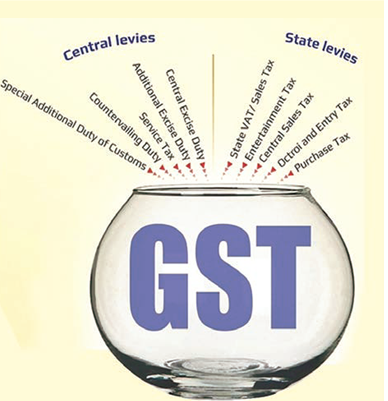
- GST is an Indirect Tax which has replaced many Indirect Taxes in India.
- The Goods and Service Tax Act was passed in the Parliament on 29th March 2017.
- The Act came into effect on 1st July 2017; Goods & Services Tax in India is a comprehensive, multi- stage, destination-based tax that is levied on every value addition.
- In simple words, Goods and Service Tax (GST) is an indirect tax levied on the supply of goods and services.
- This law has replaced many indirect tax laws that previously existed in India.
- GST is one indirect tax for the entire country.
- Under the GST regime, the tax will be levied at the final point of sale.
- In case of intra-state sales, Central GST and State GST will be charged.
- Inter-state sales will be chargeable to Integrated GST.
Destination Based
- Consider goods manufactured in Tamil Nadu and are sold to the final consumer in Karnataka.
- Since Goods & Service Tax is levied at the point of consumption, in this case, Karnataka, the entire tax revenue will go to Karnataka and not Tamil Nadu.
Components of GST
- The component of GST are of 3 types.
- They are: CGST, SGST & IGST.
- CGST: Collected by the Central Government on an intra-state sale (Eg: Within state/ union territory)
- SGST: Collected by the State Government on an intra-state sale (Eg: Within state/ union territory)
- IGST: Collected by the Central Government for inter-state sale (Eg: Maharashtra to Tamil Nadu)
- In most cases, the tax structure under the new regime will be as follows:
| Transaction | New Regime | Old Regime | |
| Sale within the State | CGST + SGST | VAT + Central Excise/Service tax | Revenue will be shared equally between the Centre and the State |
| Sale to another State | IGST | Central Sales Tax + Excise/Service Tax | There will only be one type of tax (central) in case of inter-state sales. The center will then share the IGST revenue based on the destination of goods. |
Nature of Sales tax, VAT and GST
- Sales tax was multipoint tax with cascading effect.
- VAT was multipoint tax without cascading effect.
- GST is one point tax without cascading effect.
Advantages of GST
- GST will mainly remove the cascading effect on the sale of goods and services. Removal of cascading effect will directly impact the cost of goods. Since tax on tax is eliminated in this regime, the cost of goods decreases.
- GST is also mainly technologically driven. All activities like registration, return filing, application for refund and response to notice need to be done online on the GST Portal. This will speed up the processes.
Public Debt

- In the 18th and 19th centuries, the role of the state was minimum.
- But since 20th century there has been enormous increase in the responsibilities of the state.
- Hence the state has to supplement the traditional revenue sources with borrowing from individuals, and institutions within and outside the country.
- The amount of borrowing is huge in the under developed countries to finance development activities.
- The debt burden is a big problem and most of the countries are in debt trap.
Definitions
| “The debt is the form of promises by the Treasury to pay to the holders of these promises a principal sum and in most instances interest on the principal. Borrowing is resorted to in order to provide funds for financing a current deficit.” – Philip E. Taylor |
| “The receipt from the sale of financial instruments by the government to individuals or firms in the private sector, to induce the private sector to release manpower and real resources and to finance the purchase of these resources or to make welfare payments or subsidies”. – Carl S. Shoup |
Types of Public Debt
i) Internal public debt
- An internal public debt is a loan taken by the Government from the citizens or from different institutions within the country.
- An internal public debt only involves transfer of wealth.
- The main sources of internal public debt are as follows:
- Individuals, who purchase government bonds and securities;
- Banks, both private and public, buy bonds from the Government.
- Non-financial institutions like UTI, LIC, GIC etc. also buy the Government bonds.
- Central Bank can lend the Government in the form of money supply.
- The Central Bank can also issue money to meet the expenditures of the Government.
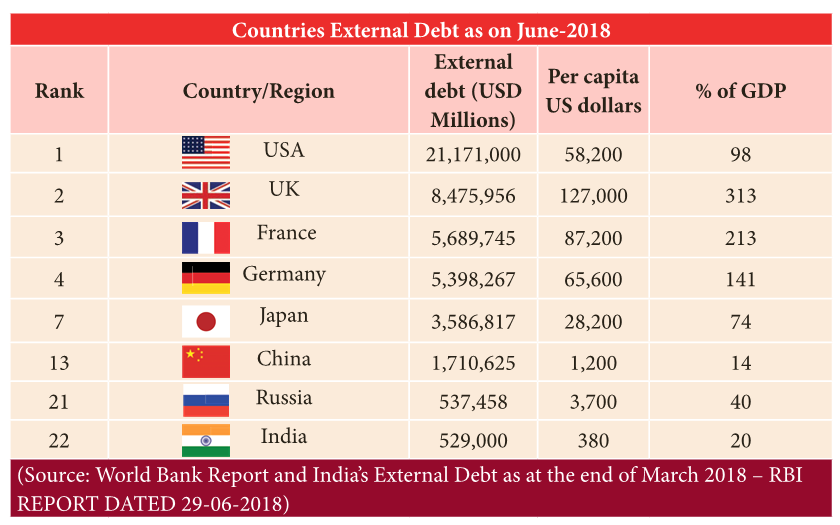
ii) External public debt
- When a loan is taken from abroad or from an international organisation it is called external public debt.
- The main sources of External public debt are IMF, World Bank, IDA and ADB etc. Loan from other countries and the Governments.
Causes for the Increase in Public debt
- The causes for enormous growth of public debt may be studied under the following sub-headings:
1. War and Preparation of war
- Waging war has become one of the important causes for incurring debts by the governments.
- In modern times, the preparation for war and nuclear defence programmes take away the major share of the government’s revenue and so it incurs debt.
2. Social obligations
- Modern states are considered to be ‘Welfare States’ and they have to undertake many social obligations like public health, sanitation, education, insurance, transport and communications, etc., besides providing the minimum necessaries of life to the citizens of the country.
- To finance these, the State has to incur a heavy public debt.
3. Economic Development and Deficit
- The government has to undertake many projects for economic development of the country.
- Construction of railways, power projects, irrigation projects, heavy industries, etc., could be thought of only by means of mobilising resources in the form of public debt.
- Due to heavy public expenditure, the governments always face deficit budget. Such deficits have to be financed only through borrowings.
4. Employment
- Most of the governments of modern days face the problem of unemployment and it has become the duty to solve this by making huge public expenditure.
- To solve the unemployment problem, and to fight recession, the government has to make huge expenditures. For this the States have to resort to public debt.
5. Controlling inflation
- The Government can withdraw excess money from circulation, by raising public debt and thus prevent prices from rising.
6. Fighting depression
- During the depression phase, private investment is lacking.
- The Government applies compensatory public spending by borrowing from internal and external sources.
Methods of Redemption of Public Debt
- The process of repaying a public debt is called redemption.
- The Government sells securities to the public and at the time of maturity, the person who holds the security surrenders it to the Government.
- The following methods are adopted for debt redemption.
(1) Sinking Fund
- Under this method, the Government establishes a separate fund known as “Sinking Fund”.
- The Government credits every year a fixed amount of money to this fund.
- By the time the debt matures, the fund accumulates enough amount to pay off the principal along with interest.
- This method was first introduced in England by Walpol.
(2) Conversion
- Conversion of loans is another method of redemption of public debt.
- It means that an old loan is converted into a new loan.
- Under this system a high interest public debt is converted into a low interest public debt.
- Dalton felt that debt conversion actually relaxes the debt burden.
(3) Budgetary Surplus
- When the Government presents surplus budget, it can be utilised for repaying the debt.
- Surplus occurs when public revenue exceeds the public expenditure. However, this method is rarely possible.
(4) Terminal Annuity
- In this method, Government pays off the public debt on the basis of terminal annuity in equal annual instalments.
- This is the easiest way of paying off the public debt.
(5) Repudiation
- It is the easiest way for the Government to get rid of the burden of payment of a loan.
- In such cases, the Government does not recognise its obligation to repay the loan.
- It is certainly not paying off a loan but destroying it.
- However, in normal case the Government does not do so; if done it will lose its credibility.
(6) Reduction in Rate of Interest
- Another method of debt redemption is the compulsory reduction in the rate of interest, during the time of financial crisis.
(7) Capital Levy
- When the Government imposes levy on the capital assets owned by an individual or any institution, it is called capital levy.
- This levy is imposed on capital assets above a minimum limit on a progressive scale.
- The fund so collected can be used by the Government for paying off war time debt obligations.
- This is the most controversial method of debt repayment.
Budget
- The word ‘budget’ is said to have its origin from the French word “Bougett” which refers to ‘a small leather bag’.
- The budget is an annual financial statement which shows the estimated income and expenditure of the Government for the forthcoming financial year.
Definitions
| “It is a document containing a preliminary approved plan of public revenue and expenditure”. -Reney Stourn. |
| “The budget has come to mean the financial arrangements of a given period, with the usual implication that they have been submitted to the legislature for approval”. – Bastabale |
Union Budget and State Budget
- India is a federal economy, hence public budget is divided into two layers of the Government.
- According to the Indian Constitution, the Central Government has to submit annual financial statement, i.e.,
- Union Budget under Article 112 to the Parliament and each State Government has to submit the same for the State in the Legislative Assembly under Article 202.
Types of Budget
Revenue and Capital Budget
- On the basis of expenditure on revenue account and other accounts, a budget can be presented in two ways:
i) Revenue Budget:
- It consists of revenue receipts and revenue expenditure.
- Moreover, the revenue receipts can be categorised into tax revenue and non-tax revenue.
- Revenue expenditure can also be categorised into plan revenue expenditure and non-plan revenue expenditure.
ii) Capital Budget:
- It consists of capital receipts and capital expenditure.
- In this case, the main sources of capital receipts are loans, advances etc.
- On the other side capital expenditure can be categorised into plan capital expenditure and non- plan capital expenditure.
iii) Supplementary Budget:
- During the time of war emergencies and natural calamities like tsunami, flood etc, the expenditures allotted in the budget provisions are not always enough.
- Under these circumstances, a supplementary budget can be presented by the Government to tackle these unforeseen events.
iv) Vote – on – Account:
- Under Article 116 of the Indian Constitution, the budget can be presented in the middle of the year.
- The reason may be political in nature. The existing Government may or may not continue for the year, on account of the fact that elections are due, then the Government places a ‘lame duck budget’.
- This is also called ‘Vote-on-account Budget’.
- The vote on account budget is a special provision by which the Government gets permission from the parliament to incur expenditures on necessary items till the budget is finally passed in the parliament.
- The legal permission of both the Houses of the parliament for the withdrawal of money from the Consolidated Fund of India to meet the requisite expenses till the budget is finally approved is known as vote-on – account budget.
- This type of budget is generally sanctioned for not more than two months.
v) Zero Base Budget:
- The Government of India presented Zero-Base-Budgeting (ZBB first) in 1987-88.
- It involves fresh evaluation of expenditure in the Government budget, assuming it as a new item.
- The review has been made to provide justification or otherwise for the project as a whole in the light of the socio-economic objectives which have been already set up for this project and as well as in view of the priorities of the society.
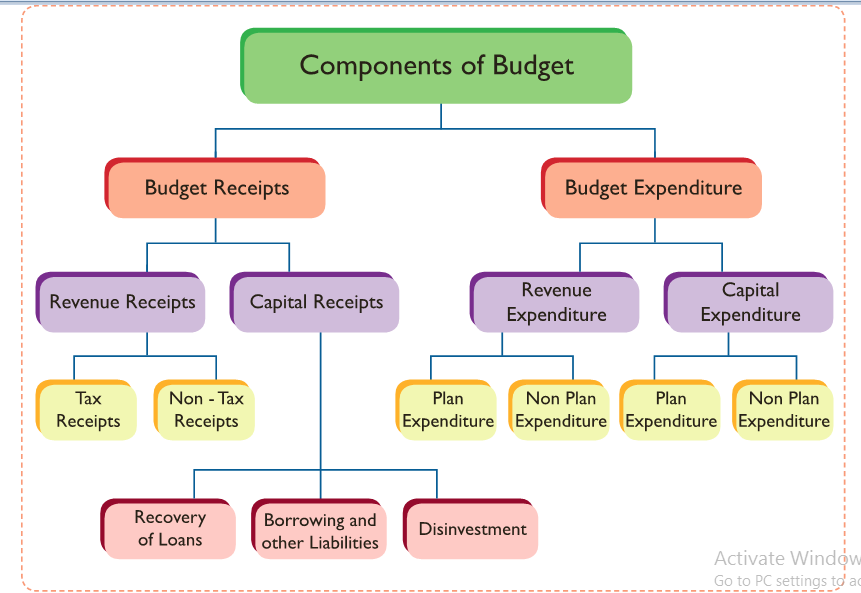
vi) Performance Budget:
- When the outcome of any activity is taken as the base of any budget, such budget is known as ‘Performance Budget’.
- For the first time in the world, the performance budget was made in USA.
- The Administrative Reforms Commission was set up in 1949 in America under Sir Hooper.
- This commission recommended making of a ‘Performance Budget’ in USA.
- In the Performance Budget, it is the compulsion of the government to tell ‘what is done’, ‘how much done’ for the betterment of the people.
- In India, the Performance Budget is also known as ‘Outcome Budget’.
vii) Balanced Budget Vs Unbalanced Budget
A. Balanced Budget
- Balanced budget is a situation, in which estimated revenue of the government during the year is equal to its anticipated expenditure.
- Government’s estimated Revenue = Government’s proposed Expenditure.
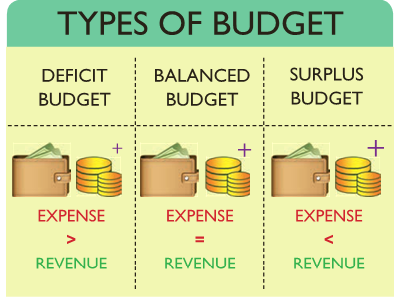
B. Unbalanced Budget
- The budget in which Revenue & Expenditure are not equal to each other is known as Unbalanced Budget.
- Unbalanced budget is of two types: 1. Surplus Budget 2. Deficit Budget
1. Surplus Budget
- The budget is a surplus budget when the estimated revenues of the year are greater than anticipated expenditures.
- Government Estimated revenue > Estimated Government Expenditure.
2. Deficit Budget
- Deficit budget is one where the estimated government expenditure is more than expected revenue.
- Government’s estimated Revenue < Government’s proposed Expenditure.
Budgetary Procedure
- Budgetary procedure refers to the system through which the budget is prepared, enacted and executed.
(A) Preparation of the Budget
- The Ministry of Finance prepares the Central Budget every year.
- At the state level the finance department is responsible for the Annual State Budget.
- While preparing the budget, the following factors are taken into account:
- The macro economic targets to be achieved within a plan period;
- The basic strategy of the budget;
- The financial requirements of different projects;
- Estimates of the revenue expenditures (includes defence expenditure, subsidy, interest payment on debt etc.);
- Estimates of the capital expenditures (includes development of railways, roadways, irrigations etc.);
- Estimates of revenue receipts from tax and non-tax revenues;
- Estimates of capital receipts from the recovery of loans, disinvestment of public sector units, market borrowings etc.
- Estimates of the gap between revenue receipts and revenue expenditure; and
- Estimates of fiscal deficit, primary deficit, and revenue deficit.
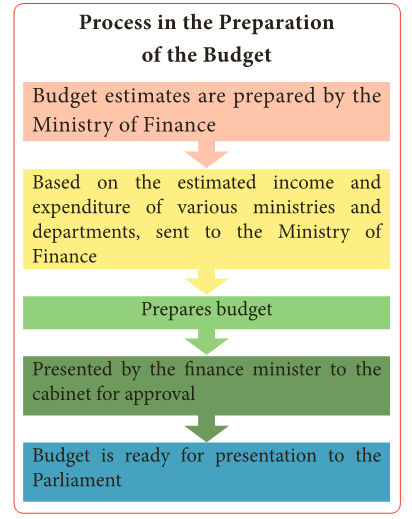
(B) Presentation of the Budget
- The hon’ble Minister of Finance, on behalf of the Central Government, places the Union Budget before Parliament on the eve of a new financial year.
- Similarly at state levels, the Hon’ble Finance Minister of the respective State Government places the State Budget before the State Legislature.
- According to the Indian Constitution, all money bills must be initiated in the Lower House.
- All the money bills are first placed before the LokSabha at the Centre, and before the VidhanSabha at the State level.
- The demands of various tax proposals are included in the budget.
- After the finance bill is passed, an appropriation bill is presented to give legal effect to the voted demands, and to authorise the expenditure as per the budget.
- In this way, the budgets are enacted in India.
(c) Execution of the Budget
- The budget is mainly executed by different departments of the Government.
- Proper execution of the budgetary provisions are important for the efficient utilisation of the allocated funds.
Parliamentary Control over the Budget
- In India, the Government Accounts are maintained in three parts:
- Consolidated Fund
- Contingency Fund
- Public Accounts
- There are also two committees of parliament, viz,
- The Public Accounts Committee, and
- The Estimates Committee.
- These committees keep a constant vigil on the expenditure so that no Ministry or Department exceeds the amount sanctioned to it.
Budgetary Deficits
- Budget deficit is a situation where budget receipts are less than budget expenditures.
- This situation is also known as government deficit.
- In reference to the Indian Government budget, budget deficit is of four major types.
- Revenue Deficit
- Budget Deficit
- Fiscal Deficit, and
- Primary Deficit
(A) Revenue Deficit
- It refers to the excess of the government revenue expenditure over revenue receipts.
- It does not consider capital receipts and capital expenditure.
- Revenue deficit implies that the government is living beyond its means to conduct day-to-day operations.
- Revenue Deficit (RD) = Total Revenue
- Expenditure (RE) – Total Revenue Receipts (RR),
- When RE – RR > 0
(B) Budget Deficit
- Budget deficit is the difference between total receipts and total expenditure (both revenue and capital)
- Budget Deficit = Total Expenditure – Total Revenue
(C) Fiscal Deficit
- Fiscal deficit (FD) = Budget deficit + Government’s market borrowings and liabilities
(D) Primary Deficit
- Primary deficit is equal to fiscal deficit minus interest payments.
- It shows the real burden of the government and it does not include the interest burden on loans taken in the past.
- Thus, primary deficit reflects borrowing requirement of the government exclusive of interest payments.
- Primary Deficit (PD) = Fiscal deficit (PD) – Interest Payment (IP)
Federal Finance
- Federal finance refers to the system of assigning the source of revenue to the Central as well as State Governments for the efficient discharge of their respective functions i.e. clear-cut division is made regarding the allocation of resources of revenue between the central and state authorities.
Division of Powers:
- In our Constitution, there is a clear division of powers so that none violates its limits and tries to encroach upon the functions of the other and functions within own sphere of responsibilities.
- There are three lists enumerated in the Seventh Schedule of constitution.
- They are: the Union list, the State list and the Concurrent List.
- The Union List consists of 100 subjects of national importance such as Defence, Railways, Post and Telegraph, etc.
- The State List consists of 61 subjects of local interest such as Public Health, Police etc.
- The Concurrent List has 52 subjects important to both the Union and the State, such as Electricity, Trade Union, Economic and Social Planning, etc.
Central State Financial Relationship
(I) Union Sources
- Corporation tax
- Currency, coinage and legal tender, foreign exchange.
- Duties of customs including export duties.
- Duties of excise on tobacco and certain goods manufactured or produced in India.
- Estate duty in respect of property other than agricultural land.
- Fees in respect of any of the matters in the Union List, but not including any fees taken in any Court.
- Foreign Loans.
- Lotteries organized by the Government of India or the Government of a State.
- Post Office Savings Bank.
- Posts and Telegraphs, telephones, wireless, Broadcasting and other forms of communication.
- Property of the Union.
- Public Debt of the Union.
- Railways.
- Rates of stamp duty in respect of Bills of Exchange, Cheques, Promissory Notes, etc.
- Reserve Bank of India.
- Taxes on income other than agricultural income.
- Taxes on the capital value of the assets, exclusive of agricultural land of individuals and companies.
- Taxes other than stamp duties on transactions in stock exchanges and future markets.
- Taxes on the sale or purchase of newspapers and on advertisements published therein.
- Terminal taxes on goods or passengers, carried by railways, sea or air.
(II) State Sources
- Capitation tax
- Duties in respect of succession to agricultural land.
- Duties of excise on certain goods produced or manufactured in the State, such as alcoholic liquids, opium, etc.
- Estate duty in respect of agricultural land.
- Fees in respect of any of the matters in the State List, but not including fees taken in any Court.
- Land Revenue.
- Rates of stamp duty in respect of documents other than those specified in the Union List.
- Taxes on agricultural income.
- Taxes on land and buildings.
- Taxes on mineral rights, subject to limitations impose by Parliament relating to mineral development.
- Taxes on the consumption or sale of electricity.
- Taxes on the entry of goods into a local area for consumption, use or sale therein.
- Taxes on the sale and purchase of goods other than newspapers.
- Taxes on the advertisements other than those published in newspapers.
- Taxes on goods and passengers carried by road or on inland waterways.
- Taxes on vehicles.
- Taxes on animals and boats.
- Taxes on professions, trades, callings and employments.
- Taxes on luxuries, including taxes on entertainments, amusements, betting and gambling.
- Tolls.
(III) Taxes Levied and Collected by the union but Assigned to the States (Art.269)
- Duties in respect of succession to property other than agricultural land.
- Estate duty in respect of property other than agricultural land.
- Taxes on railway fares and freights.
- Taxes other than stamp duties on transactions in stock exchanges and future markets.
- Taxes on the sale or purchase of newspapers and on advertisements published therein
- Terminal taxes on goods or passengers carried by railways, sea or air.
- Taxes on the sale or purchase of goods other than newspapers where such sale or purchase taxes place in the course of inter-State trade or commerce.
(IV) Duties levied by the Union but collected and Appropriated by the states (Art.268)
- Stamp duties and duties of excise on medicinal and toilet preparation (those mentioned in the Union List) shall be levied by the Government of India but shall be collected.
- In the case where such duties are leviable within any Union territory, by the Government of India.
- In other cases, by the States within which such duties are respectively leviable.
(v) Taxes which are Levied and Collected by the Union but which may be Distributed between the Union and the States (Arts.270 and 272)
- Taxes on income other than agricultural income.
- Union duties of excise other than such duties of excise on medicinal and toilet preparations as are mentioned in the Union List and collected by the Government of India.
- “Taxes on income” does not include corporation tax.
- The distribution of income-tax proceeds between the Union and the States is made on the recommendations of the Finance Commission.
Principles of Federal Finance
- In the case of federal system of finance, the following main principles must be applied:
- Principle of Independence.
- Principle of Equity.
- Principle of Uniformity.
- Principle of Adequacy.
- Principle of Fiscal Access.
- Principle of Integration and coordination.
- Principle of Efficiency.
- Principle of Administrative Economy.
- Principle of Accountability.
1. Principle of Independence
- Under the system of federal finance, a Government should be autonomous and free about the internal financial matters concerned.
- It means each Government should have separate sources of revenue, authority to levy taxes, to borrow money and to meet the expenditure.
- The Government should normally enjoy autonomy in fiscal matters.
2. Principle of Equity
- From the point of view of equity, the resources should be distributed among the different states so that each state receives a fair share of revenue.
3. Principle of Uniformity
- In a federal system, each state should contribute equal tax payments for federal finance.
- But this principle cannot be followed in practice because the taxable capacity of each unit is not of the same.
4. Principle of Adequacy of Resources
- The principle of adequacy means that the resources of each Government i.e. Central and State should be adequate to carry out its functions effectively.
- Here adequacy must be decided with reference to both current as well as future needs.
- Besides, the resources should be elastic in order to meet the growing needs and unforeseen expenditure like war, floods etc.
5. Principle of Fiscal Access
- In a federal system, there should be possibility for the Central and State Governments to develop new source of revenue within their prescribed fields to meet the growing financial needs.
- In nutshell, the resources should grow with the increase in the responsibilities of the Government.
6. Principle of Integration and coordination
- The financial system as a whole should be well integrated.
- There should be perfect coordination among different layers of the financial system of the country.
- Then only the federal system will survive.
- This should be done in such a way to promote the overall economic development of the country.
7. Principle of Efficiency
- The financial system should be well organized and efficiently administered.
- There should be no scope for evasion and fraud.
- No one should be taxed more than once in a year.
- Double taxation should be avoided.
8. Principle of Administrative Economy
- Economy is the important criterion of any federal financial system.
- That is, the cost of collection should be at the minimum level and the major portion of revenue should be made available for the other expenditure outlays of the Governments.
9. Principle of Accountability
- Each Government should be accountable to its own legislature for its financial decisions i.e the Central to the Parliament and the State to the Assembly.
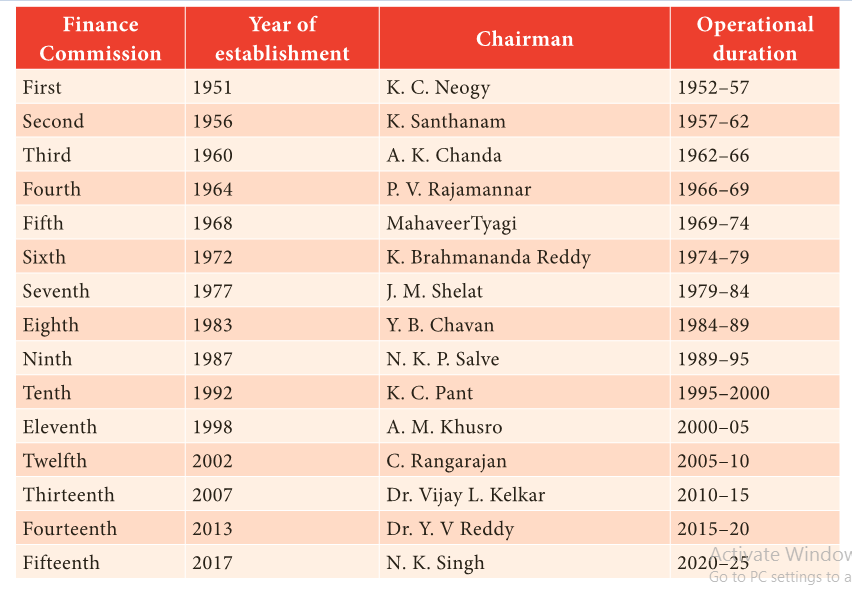
History of Finance Commission
- Finance commission is a quasi- judicial body set up under Article 280 of the Indian Constitution.
- It was established in the year 1951, to define the fiscal relationship framework between the Centre and the state.
- Finance Commission aims to reduce the fiscal imbalances between the centre and the states (Vertical imbalance) and also between the states (horizontal imbalance). It promotes inclusiveness.
- A Finance Commission is set up once in every 5 years. It is normally constituted two years before the period. It is a temporary Body.
- The 14th Finance Commission was set up in 2013. Its recommendations were valid for the period from 1st April 2015 to 31st March 2020.
- The 15th Finance Commission has been set up in November 2017.
- Its recommendations will be implemented starting 1 April 2020.
Functions of Finance Commission of India
- Article 280 (3) speaks about the functions of the Finance Commission.
- The Article states that it shall be the duty of the Commission to make the recommendations to the President as to:
- The distribution between the Union and the States of the net proceeds of taxes, which may be divided between them and the allocation among the states of the respective shares of such proceeds;
- To determine the quantum of grants- in-aid to be given by the Centre to states [Article 275 (1)] and to evolve the principles governing the eligibility of the state for such grant-in-aid;
- Any other matter referred to the Commission by the President of India in the interest of sound finance.
- Several issues like debt relief, financing of calamity relief of states, additional excise duties, etc. have been referred to the Commission invoking this clause.
How taxes are split
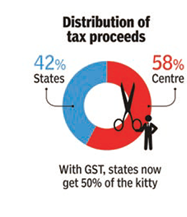
- Article 280 of the Constitution mandates the finance commission to recommend the distribution of the net proceeds of taxes between the Centre and the states every five years.
- 15th Finance Commission’s recommendations on tax sharing between Centre and States are to kick in form April 2020
Local Finance
- Local finance refers to the finance of local bodies in India. There is a large variety of local bodies in India.
- We have the following main four local bodies which are functioning today in our country:
Types of Local Bodies
- Village Panchayats
- District Boards or Zila Parishads
- Municipalities
- Municipal Corporations
1. Village Panchayats:

- Establishment: The jurisdiction of a panchayat is usually confined to one revenue village.
- In some cases, though not very frequently, two or more small villages are grouped under one panchayat.
- The establishment of panchayat raj is the avowed policy of most states in India.
Functions
- The functions of panchayats range over a wide area including civil, economic and so on. Thus small disputes may be disposed of by panchayats on the spot.
- Roads, primary schools, village dispensaries etc. are to be managed by panchayats.
- The supply of water, both for drinking and irrigation, falls within their field of responsibility, and in some cases farming, marketing, storage, etc. are entrusted to them.
Sources of revenue of Village Panchayats
- The following are the sources of revenue of village panchayats.
- general property tax,
- taxes on land,
- profession tax, and
- tax on animals and vehicles.
- Other taxes include service tax, octroi, theatre tax, pilgrim tax, tax on marriage, tax on birth and deaths, and labour tax.
- As a matter of fact, taxes are levied by the panchayats only with the sanction of the state government, and there are certain limits in respect of tax rates which have to be observed.
District Boards Or ZilaParishads:

- Establishment: In rural areas, district boards or Zila Parishads are established at district level.
- The territorial jurisdiction of a district board is generally a revenue district.
Functions
- In Tamil Nadu, the Zila Parishad is a co-ordinating body which exercises general supervision over the working of Panchayat Samitis and advises them on implementation of Development Schemes.
Sources of revenue of District Boards
- Grants-in-aid from the state government.
- Land Cesses.
- Toll, fees etc.
- Income from the property and loans from the state governments.
- Grants for the centrally sponsored schemes relating to development work.
- Income from fairs and exhibitions.
- Property tax and other taxes which the state governments may authorise the district boards.
3. Municipalities
- Establishment and Functions: The municipalities are bodies or institutions which are established in urban areas for looking after local affairs, such as, sanitation, public health, local roads, lighting, water supply, cleaning of streets, maintenance of parks and gardens, maintenance of hospitals, dispensaries and veterinary hospitals, provision of drainage, provision of primary education, organising of fairs and exhibitions etc.
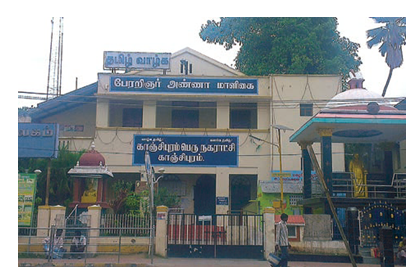
- However, all these functions are performed subject to the control of the state government.
Sources of revenue of municipalities
- taxes on property
- taxes on goods, particularly octroi and terminal tax
- personal taxes, taxes on profession, trades and employment
- taxes on vehicles and animals
- theatre or show tax, and
- grants-in-aid from state government.
4. Municipal Corporations
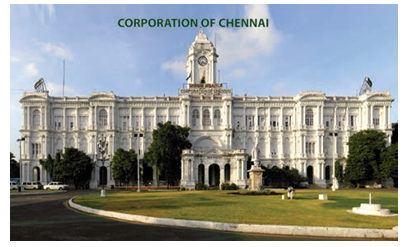
Establishment and Functions:
- The municipal corporations have wide powers and enjoy greater freedom as compared to municipalities.
- The municipal corporations are usually entrusted with the functions, such as, water supply and drainage, lighting, roads, slum clearance, housing and town planning etc.
- The rapid increase in the population of cities has definitely added to the functions of municipal corporations.
Sources of revenue of Corporations
- tax on property,
- tax on vehicles and animals,
- tax on trades, calling and employment,
- theatre and show tax,
- taxes on goods brought into the cities for sale,
- taxes on advertisements,
- octroi and terminal tax etc.
- The corporations have a fair degree of freedom in respect of their choice and modification of these taxes, subject to the maximum and minimum rates laid down by the law.
Fiscal policy
- As an instrument of macro-economic policy, fiscal policy has been very popular among modern governments.
- The growing importance of fiscal policy was due to the Great Depression and the development of ‘New Economics’ by Keynes.
Meaning of Fiscal Policy
- In common parlance fiscal policy means the budgetary manipulations affecting the macro economic variables – output, employment, saving, investment etc.
Definitions
| “The term fiscal policy refers to a policy under which the Government uses its expenditure and revenue programmes to produce desirable effects and avoid undesirable effects on the national income, production and employment” – Arthur Smithies |
| “By fiscal policy is meant the use of public finance or expenditure, taxes, borrowing and financial administration to further our national economic objectives” – Buehler |
Fiscal Instruments
- Fiscal Policy is implemented through fiscal instruments also called ‘fiscal tools’ or fiscal levers: Government expenditure, taxation and borrowing are the fiscal tools.
i) Taxation:
- Taxes transfer income from the people to the Government.
- Taxes are either direct or indirect. An increase in tax reduces disposable income.
- So taxation should be raised to control inflation.
- During depression, taxes are to be reduced.
ii) Public Expenditure:
- Public expenditure raises wages and salaries of the employees and thereby the aggregate demand for goods and services.
- Hence public expenditure is raised to fight recession and reduced to control inflation.
iii) Public debt:
- When Government borrows by floating a loan, there is transfer of funds from the public to the Government.
- At the time of interest payment and repayment of public debt, funds are transferred from Government to public.
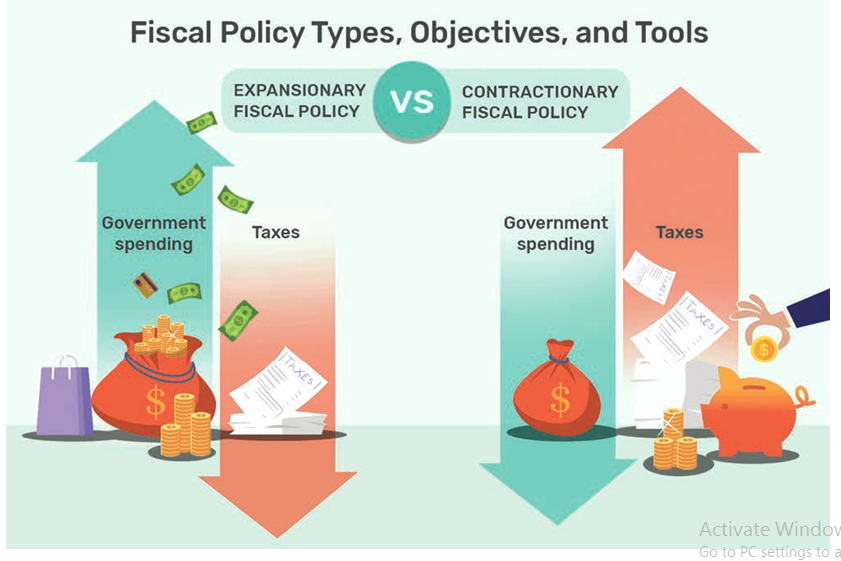
Objectives of Fiscal Policy:
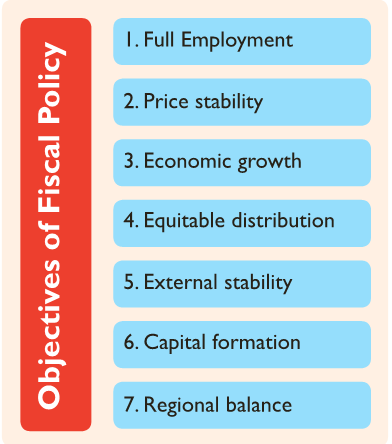
- Objectives of Fiscal Policy
- Full Employment
- Price stability
- Economic growth
- Equitable distribution
- External stability
- Capital formation
- Regional balance
- The Fiscal Policy is useful to achieve the following objectives:
1. Full Employment
- Full Employment is the common objective of fiscal policy in both developed and developing countries.
- Public expenditure on social overheads help to create employment opportunities.
- In India, public expenditure on rural employment programmes like MGNREGS is aimed at employment generation.
2. Price Stability
- Price instability is caused by mismatch between aggregate demand and aggregate supply.
- Inflation is due to excess demand for goods.
- If excess demand is caused by Government expenditure in excess of real output, the most effective measure is to cut down public expenditure.
- Taxation of income is the best measure if excess demand is due to private spending. Taxation reduces disposable income and so aggregate demand.
- To fight depression, the Government needs to increase its spending and reduce taxation.
3. Economic Growth
- Fiscal Policy is used to increase the productive capacity of the economy.
- Tax is to be used as an instrument for encouraging investment.
- Tax holidays and tax rebates for new industries stimulate investment.
- Public sector investments are to be increased to fill the gap left by private investment.
- When resource mobilization through tax measures is inadequate, the Government resorts to borrowing both from internal and external sources to finance growth projects.
4. Equitable distribution
- Progressive rates in taxation help to reduce the gap between rich and poor.
- Similarly progressive rates in public expenditure through welfare schemes such as free education, noon meal for school children and subsidies promote the living standard of poor people.
5. Exchange Stability
- Fluctuations in international trade cause movements in exchange rate.
- Tax concessions and subsidy to export oriented units help to boost exports.
- Customs duties on import of non-essential items help to cut import bill.
- The reduction in import duty on import of raw material and machinery enables reduction in cost and make the exports competitive.
6. Capital formation
- Capital formation is essential for rapid economic development.
- Tax relief helps to increase disposable income, savings and thereby capital formation.
- Government expenditure on infrastructure development like power and transport encourages private investment.
7. Regional balance
- Fiscal incentives for industries in the backward regions help to narrow down regional imbalances.
- Public expenditure may be used to start industrial estates so that industrial activity is stimulated in backward regions.
Summary:
- The science of public finance deals with the revenue and expenditure of the Centre, state and local Government.
- In modern times, this subject includes five major divisions:
- Public revenue,
- Public expenditure,
- Public debt,
- Fiscal administration and
- Fiscal Policy.
- Thus, public finance plays a vital role in both developed and underdeveloped economies.
- In advanced or developed economies, this is a problem of economic instability due to either ‘lack of demand’ or ‘excess of demand’.
- In under developed countries, fiscal policy is one of the instruments for achieving faster economic growth.
- Fiscal Policy became popular after the Great Depression.
- Governments intervention was emphasised by J.M.Keynes to get the economies out of the Depression.
- There is close association between governments spending, private investment, interest rate, consumption and income growth.